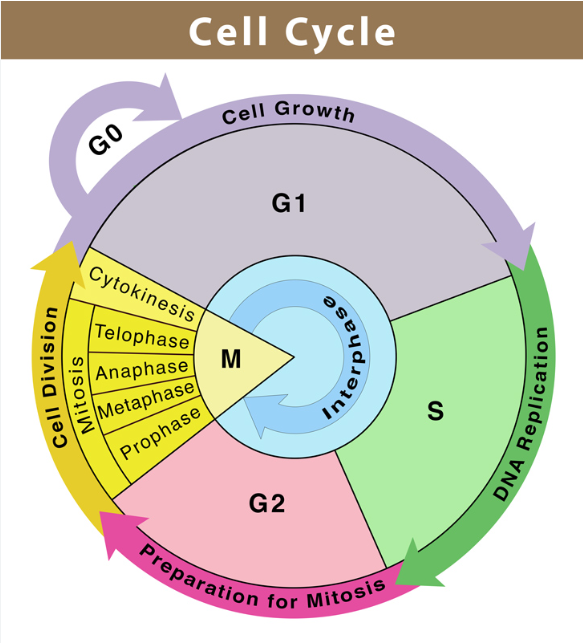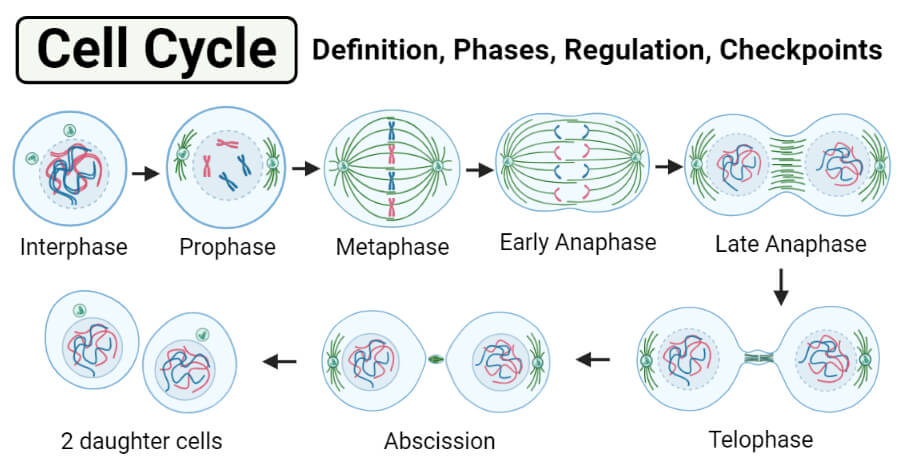The sequence of events by which a cell duplicates its genome, synthesizes the other constituents of the cell and eventually divides into two daughter cells is termed cell cycle.
Cell division is a very important process in all living organisms. During the division of a cell, DNA replication and cell growth also take place. All these processes, i.e., cell division, DNA replication, and cell growth, hence, have to take place in a coordinated way to ensure correct division and formation of progeny cells containing intact genomes.
Although cell growth (in terms of cytoplasmic increase) is a continuous process, DNA synthesis occurs only during one specific stage in the cell cycle. The replicated chromosomes (DNA) are then distributed to daughter nuclei by a complex series of events during cell division. These events are themselves under genetic control.
Growth and reproduction are characteristics of cells, indeed of all living organisms. All cells reproduce by dividing into two, with each parental cell giving rise to two daughter cells each time they divide. These newly formed daughter cells can themselves grow and divide, giving rise to a new cell population that is formed by the growth and division of a single parental cell and its progeny.



Phases of Cell Cycle
A typical eukaryotic cell cycle is illustrated by human cells in culture. These cells divide once in approximately every 24 hours (as shown in below figure).

However, this duration of cell cycle can vary from organism to organism and also from cell type to cell type. Yeast for example, can progress through the cell cycle in only about 90 minutes. The cell cycle is divided into two basic phases:
- Interphase
- M Phase (Mitosis phase)
The M Phase represents the phase when the actual cell division or mitosis occurs and the interphase represents the phase between two successive M phases. It is significant to note that in the 24 hour average duration of cell cycle of a human cell, cell division proper lasts for only about an hour. The interphase lasts more than 95% of the duration of cell cycle.
The M Phase starts with the nuclear division, corresponding to the separation of daughter chromosomes (karyokinesis) and usually ends with division of cytoplasm (cytokinesis).
The interphase, though called the resting phase, is the time during which the cell is preparing for division by undergoing both cell growth and DNA replication in an orderly manner. The interphase is divided into three further phases:
- G1phase (Gap 1)
- S phase (Synthesis)
- G2phase (Gap 2)
G1phase corresponds to the interval between mitosis and initiation of DNA replication. During G1phase the cell is metabolically active and continuously grows but does not replicate its DNA. S or synthesis phase marks the period during which DNA synthesis or replication takes place. During this time the amount of DNA per cell doubles. If the initial amount of DNA is denoted as 2C then it increases to 4C. However, there is no increase in the chromosome number; if the cell had diploid or 2n number of chromosomes at G1, even after S phase the number of chromosomes remains the same, i.e., 2n.
In animal cells, during the S phase, DNA replication begins in the nucleus, and the centriole duplicates in the cytoplasm. During the G2phase, proteins are synthesized in preparation for mitosis while cell growth continues.
Some cells in the adult animals do not appear to exhibit division (e.g., heart cells) and many other cells divide only occasionally, as needed to replace cells that have been lost because of injury or cell death. These cells that do not divide further exit G1 phase to enter an inactive stage called quiescent stage (G0) of the cell cycle. Cells in this stage remain metabolically active but no longer proliferate unless called on to do so depending on the requirement of the organism.
